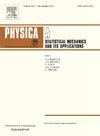分析清洁和肮脏的加密货币与能源市场之间的相互联系
IF 2.8
3区 物理与天体物理
Q2 PHYSICS, MULTIDISCIPLINARY
Physica A: Statistical Mechanics and its Applications
Pub Date : 2025-06-14
DOI:10.1016/j.physa.2025.130769
引用次数: 0
摘要
随着全球对环境可持续性的日益关注,清洁能源的应用和加密货币市场的能源效率变得越来越重要。本文使用了2018年3月至2024年7月期间清洁加密货币市场、肮脏加密货币市场和能源市场的每周数据。它采用自动编码器对五个干净的加密货币市场和四个脏的加密货币市场进行降维,以计算相应的指数。随后,构建了R-vine copula模型,分析了三个市场之间的结构关系和相关性。然后构建向量自回归(VAR)模型,进行格兰杰因果检验和Diebold &;Yilmaz方差分解分析市场间的风险溢出。研究结果表明,太阳能在能源领域发挥着核心作用,弥合了清洁能源和肮脏能源之间的差距。以太坊(ETH)通过其区块链技术和去中心化应用,已经成为连接能源市场、清洁加密货币市场和肮脏加密货币市场的重要纽带。此外,加密货币市场和能源市场之间的风险溢出存在显著的不对称性,短期和长期溢出都表现出类似的不对称性。煤炭、风能和太阳能是风险的接受者,而加密货币、原油和天然气则是风险的主要来源。投资者应关注受其他市场影响较小的石油和加密货币市场,而监管机构应针对太阳能和风能市场实施量身定制的策略,这些市场对外部风险的反应更强烈,以防止波动。本文章由计算机程序翻译,如有差异,请以英文原文为准。
Analyzing the interconnections between clean and dirty cryptocurrency and energy markets
With the increasing global attention to environmental sustainability, the application of clean energy and the energy efficiency of the cryptocurrency market have become increasingly important. This paper uses weekly data from March 2018 to July 2024 on the clean cryptocurrency market, dirty cryptocurrency market, and the energy market. It applies an autoencoder for dimensionality reduction of five clean cryptocurrency markets and four dirty cryptocurrency markets to calculate the corresponding indices. Subsequently, an R-vine copula model is constructed to analyze the structural relationships and correlations among the three markets. The study then constructs a vector autoregressive (VAR) model and conducts Granger causality tests and Diebold & Yilmaz variance decomposition to analyze the risk spillovers between the markets. The results indicate that solar energy plays a central role in the energy sector, bridging the gap between clean and dirty energy. Ethereum (ETH), through its blockchain technology and decentralized applications, has become an important link connecting the energy market, clean cryptocurrency market, and dirty cryptocurrency market. Furthermore, there exists a significant asymmetry in risk spillovers between the cryptocurrency market and the energy market, with both short-term and long-term spillovers showing similar asymmetries. Coal, wind energy, and solar energy act as risk receivers, while cryptocurrencies, crude oil, and natural gas primarily contribute to risk. Investors should focus on oil and cryptocurrency markets, less affected by others, while regulators should implement tailored strategies for solar and wind energy markets, which react more strongly to external risks, to prevent volatility.
求助全文
通过发布文献求助,成功后即可免费获取论文全文。
去求助
来源期刊
CiteScore
7.20
自引率
9.10%
发文量
852
审稿时长
6.6 months
期刊介绍:
Physica A: Statistical Mechanics and its Applications
Recognized by the European Physical Society
Physica A publishes research in the field of statistical mechanics and its applications.
Statistical mechanics sets out to explain the behaviour of macroscopic systems by studying the statistical properties of their microscopic constituents.
Applications of the techniques of statistical mechanics are widespread, and include: applications to physical systems such as solids, liquids and gases; applications to chemical and biological systems (colloids, interfaces, complex fluids, polymers and biopolymers, cell physics); and other interdisciplinary applications to for instance biological, economical and sociological systems.

 求助内容:
求助内容: 应助结果提醒方式:
应助结果提醒方式:


